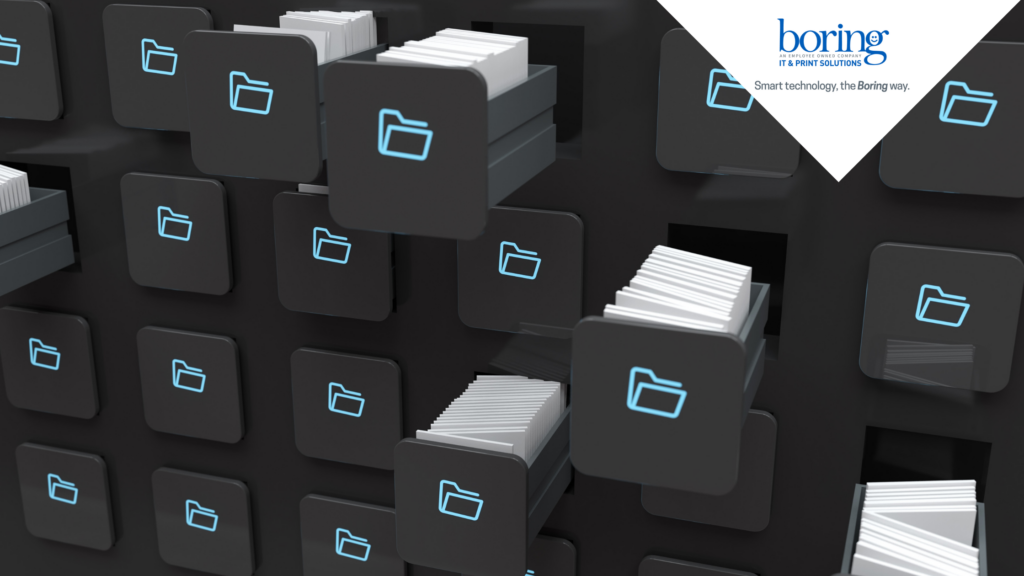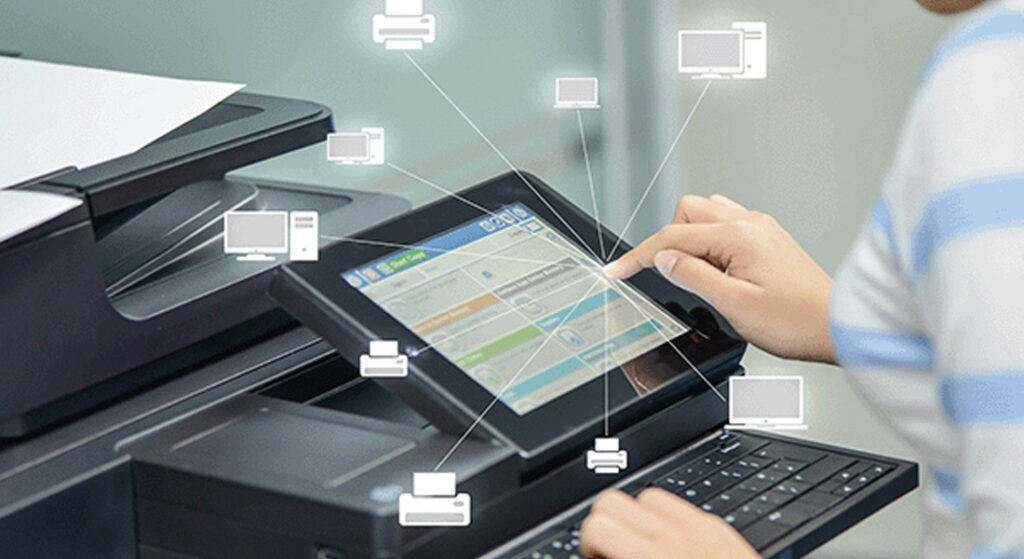Is your business ready for Cloud Print Management?

How do you know if your business is suited to cloud print management? If you’re a smaller business, whether you want to track and manage or enable your printing, you have more options than running a print server on-premise. You can now manage your printing in the public cloud. But how do you know you’re suited to serverless printing? What’s the checklist? Oh you better believe that’s a hackneyed set-up for a listicle! 4 signs you’re ready for print management in the cloud 1. You’re already in the public cloud More specifically, you’re already using the public cloud for most of your organization’s work. Many SMB workplaces don’t start up with server racks for their data storage. They outsource to Google Drive or Dropbox. Likewise with the various software-as-a-service (SaaS) business applications found in the likes of Google Workspace and Microsoft 365. For these workplaces, it makes sense to also utilize cloud print management solutions. No point in just having a print server if all the rest of your work needs are satisfied by cloud-based software. 2. You’re new to print management For years you’ve had one MFP or a couple of small A4 printers used by a handful of employees in a modestly sized office. You know who’s coming and going, you know who’s printing what, you’re not printing anything more confidential than regular office documents. You’ve never felt the need for print tracking and monitoring. Especially when considering it means you have to shell out more cash for a print server and ongoing IT maintenance. Well, now is your time to dip your toe in the water. COVID-19 has accelerated adoption of cloud services for a variety of business worktools and print management is no exception. With cloud print management, you’re not purchasing any additional equipment or budgeting for resources – it removes the print server from the equation. That means no ongoing maintenance costs – that’s all-inclusive in the cloud print management SaaS model. Once upon a time, there was a barrier to print management for businesses that couldn’t justify the expenditure on infrastructure. That’s no longer the case with cloud print management solutions. 3. You’re embracing hybrid/remote working Covid-19 forced a change to professional life that was well overdue: you can be just as productive (if not more) working from home. Since undertaking remote working out of necessity during the pandemic, many businesses worldwide are adopting hybrid working models with a split between office and home working. With workers now coming and going from the office, this redefines many a workplace’s approach to printing. For end-users, sometimes they’ll need to press print in one location and collect their job at another. For IT teams and sysadmins, they require the ability to manage and track printing remotely and on location. With cloud print management and enablement, end-users can juggle between printing at home or the office. Similarly, sysadmins and IT staff can manage printing flexibly. 4. You’re an early tech adopter Print management in the public cloud isn’t new, but it’s still a maturing technology. It will take some time before cloud-native solutions reach the same feature-set and embedded functionality as on-prem and private hosted print management solutions. But for those futurists out there who love getting their hands on new technologies, cloud-native print management is your moment. Remember how smug your Gen Z coworker was when they were early on the TikTok hype train? That could be you! Interested in learning more about our Document Management solutions? Give us a call or shoot us a message here: https://boring.com/contact-us/ Source: Papercut Blog
Common Misconceptions About MPS

How many times have you heard the term “managed print services?” What images does it bring to mind? Many people write off MPS because they do not fully understand how it works and how it could scale for their business. A few common misconceptions about Managed Print Services: Managed Print Services refers to large-scale production. When you hear the term “Managed Print Service” or MPS, does the image of a large printer press come to mind? Are you thinking about letterhead, business cards and brochures? Don’t worry, it’s a common misconception, so let’s clearly define what MPS is and how a Managed Print Services environment can improve your office’s everyday printing, copying and faxing tasks. MPS is all about what and how your office prints on the printers that reside in your office(s). (Source: MPS Made Simple) You have to have new printers to use MPS. Whether the printers are old or brand new, you can definitely benefit from a MPS program. Supplies costs can be managed through a contract, and there is peace of mind that all support and services are being handled. Insight into your overall print and copy infrastructure is also something that anyone can benefit from. You need a lot of print and copy devices for MPS to be worthwhile. Although companies with bigger device infrastructures can most definitely take advantage of MPS, smaller companies may be able to, as well. In some cases, it may depend on whether your organization currently has paper intensive processes (e.g., small law firms, insurance agencies, or real estate sites) where output may need to be managed more effectively. The only way to find out if MPS is right for you is to ask an MPS service provider, like Boring. You can only have one brand of printer in order to use MPS. As a multi-line vendor, Boring’s Managed Print Services can incorporate any number of different products. Our priority is to create an optimally efficient print environment for our customers, regardless of brand. We sell and service printers and imaging systems from HP, Lexmark, Canon, and Konica Minolta. MPS is too expensive. Another common myth, this often puts companies off seeking managed print services. The reality is that MPS has been shown to actually save companies money. In comparison to traditional break it support, managed print solutions work on a monthly set rate, and with a great deal of saved resources through effective print management, companies can see a significant effect on their bottom line. Cost-savings is actually one of the primary reasons that companies consider MPS. The upfront costs of MPS are too high. In some cases, there are little or no upfront costs to get into a MPS program. In most cases, you will end up saving money that you were originally going to spend on your print and copy environments. (Source: What to Expect When Engaging in Managed Print Services) Equipment resellers or dealers can’t compete with equipment manufacturers on MPS. Resellers and dealers, like Boring, can provide competitive MPS programs similar to equipment manufacturers. Because we are not limited to one brand, Boring can create customized print environments that may satisfy your requirements better than single-line equipment manufacturers. Contact a Boring MPS Specialist for a personalized assessment to learn more. Working with multiple vendors keeps prices low. One of the benefits of MPS is to organize your fractured infrastructure under a single contract so that there are fewer vendors to manage. In addition, a single vendor can look at your entire infrastructure holistically to insure the most cost efficient environment. You can manage your own print resources without professional help. As another myth intended to try to save money, this route is never going to get results. Just as you wouldn’t try a DIY job to fix your broken tooth, you should not be trying to manage your printing yourself – unless you have the software, skills and experience possessed by professional MPS providers. Even if your printing is reduced, you will not be able to enjoy solutions such as print audit or print management software. You would also be forced to take time from your primary job role to deal with printer issues, which defeats the whole point in the long run. Rather than trying to manage your print fleet on your own, it would make much more sense to hire a managed print services provider, such as Boring, who can help you make the most of your printing practices, saving you money and time. (Source: Common Managed Print Services Myths) Would you like to learn more about Managed Print Services? Click here. To speak with aManaged Print Services Specialist863-686-3167or Contact Us
The Upkeep: Maintaining Your Digital Documents

In this episode of our blog, we are going to go over how to keep those digital documents digital. Most companies that you talk to have already done or are in the process of digitizing all their files. Some may have them saved in their local files, some in a form of cloud-based storage, and others have moved those files to their CRM. Let’s go over some of the departments that may not be keeping those day forward files digital and may still be creating paper-based docs that tend to get lost or misfiled. Accounting – Accounting can be either AP or AR, so this will go over several documents that they have that may still be paper based. Invoices – Companies still rely on printed invoices to send to their clients. Because of the reliance on the Postal Service, it takes longer now to get to the client meaning it takes longer for your company to get paid. This is the same on your end as it now takes longer to pay those invoices and does not allow you to take advantage of early pay discounts. It also means that those invoices could be lost or mis-filed leading to late charges and possibly affecting those relationships with clients or vendors. Expenses – Using paper receipts to capture expenses for the company. This leads to missed charges, late repayment of those expenses, or no reimbursement at all if you cannot recreate the receipt. Delivery Forms – Because there are so many ways to get goods to clients, relying on paper delivery forms can create issues. You cannot charge a client for your goods without proof of delivery, and you would not want to be charged for something delivered if it cannot be proven it was delivered and signed for. HR – HR still heavily relies on paper forms to capture information that they need for the employee profile and file. Repetitive filling out of forms, missing information, and requesting forms for equipment that is needed for the position. Sales – Sales has multiple documents that are important to the company, yet still rely on paper-based processes to move through companies. Sales Packets – These are the lifeblood for any organization with sales teams. Most of the documents are still paper based. Even though companies may be using digital signature capture to get docs signed, they are still internally processing it using paper-based workflows. Customer Documents – These are previous deals, correspondence, proposals, and more. Typically, these documents are kept either paper-based or digital. The real challenge is whether paper-based or digital, trying to find the right document can be a challenge. With CRM’s, you cannot use keyword searching to locate documents. This can be a challenge if you are looking for specific documents that you may not have all the information on, or if it was mistakenly put in the wrong place. In keeping with the theme of keeping docs digital, next blog will go over some ideas and best practices in order to digitize current workflows within your organization. Contact us today to learn more about document digitization! Author: Tom Hubler, Technical Solutions Consultant at Boring
How to Digitize Your Documents and Best Practices

Document digitization is the future of document storage for companies that want to be ahead of the curve. Work from home and hybrid work environments do not allow for traditional file storage as most companies now know it. Rising rents and flexible work schedules are also accelerating this move to digitization with many companies. In this episode of the Boring Blog, we are going to go over the rules and best practices for document digitization. Rule 1 – Decide what would need to be digitized first: Many companies start by scanning / storing all their documents. Depending on how your retention policy is set up, you may just want to start with day forward and then look at what needs to be kept. Once you decide this, you’ll need to see if you have a scanner that can handle the volume of documents needing to be digitized. Typically, you can use a desktop scanner or copier / MFP. If the volume is too large for either of these devices, you may need to look at a dedicated high-speed scanner. You may even need to look at a 3rd party that specializes in this type of work if you do not have the manpower for the project available in-office. Rule 2 – Decide how you would like the documents indexed: Once you set up how these documents are going to be named, stick to it. If you take all the time to digitize your files, index fields make sure that you can find and identify those documents in your system. If you decide to outsource, they will ask you for these fields in advance to make sure the documents are indexed correctly. Rule 3 – Decide who needs to have access to the documents: If these documents need to be accessed by large numbers of people, you may want to look at a cloud-based software to store your documents rather than local storage. You may also want to look at this if you are worried about disaster recovery or if the documents in question are mission critical. Cloud-based document management systems are highly secure and easily accessible from a web browser or even a mobile device. They also save multiple copies of your documents in different data centers in case of disaster or accidental deletion. You can also set up rules regarding who can access documents and what they can do with them. Rule 4 – How to handle the old documents: Depending on your industry, a digital copy of a document is just as compliant as a paper one. If your industry requires paper, you then need to look at the retention schedule. With this in mind, you can then look at the retention schedule of your industry and decide if you need to keep or shred them after digitization. Once you have this answer to this question, you can set up the retention policy or just securely shred the documents. In the next Boring Blog, we are going to go over how you can keep digital documents digital and make them actionable with a cloud-based Document Management System. Contact us to learn more about our Document Management Solutions! Author: Tom Hubler, Technical Solutions Consultant at Boring
The Benefits of Document Digitization

Document digitization is the future of document storage for companies now and in the future. Work from home and hybrid work environments do not allow for traditional file storage as most companies now know it. Rising rents and flexible work schedules are also accelerating this move to digitization with many companies. Right now, companies are paying $25,000 to file a file cabinet and $2,000 a year to maintain that same cabinet. The average commercial office is using 50 to 70% of the floorspace just to store those documents. This doesn’t even begin to address the companies and government agencies that use off premises storage for their documents If you need to know what it is costing your company, you can use this chart to calculate: Paper Costs = Monthly Paper Costs x 12 months File Storage Costs = Number of Filing Cabinets x 16 sq. ft. x Cost per sq. ft. of Office Space Third-Party Storage Costs = Monthly Rent x 12 months Printing Costs = Printer Rental Price + Annual Printer Maintenance Fees + Monthly Ink Cost x 12 months Printer Costs: If you purchased your printers, check your records to average their yearly cost. Print-Related Labor Costs = Labor Hours Spent Managing Paper x Average Hourly Wage x Number of Workdays per Year After you look at the cost of this to your office, you may then have to look at another aspect of paper files, accessibility. With work-from-home and hybrid environments, your workers may not be able to access the documents that they need to perform their jobs effectively. This means lower productivity and higher costs to process tasks for your company. Digitization can be easy if done right. Scanning documents into a traditional Windows folder structure could lead to more confusion and misplaced files if there is not a simple and effective way to retrieve those files when needed. This is where a Content Management System or Document Management System comes into play. These systems allow for full text search and a more structured system for filing and retrieving those documents. Bonus, they are typically cloud based, which means that they can be accessed anywhere with a secure log-in and you do not have to worry about the extra burden on your IT infrastructure. Contact us to help make your office more efficient, streamlined and productive! Author: Tom Hubler, Technical Solutions Consultant at Boring
5 Benefits Of Using A Managed Services Provider

Technology continues to play an increasingly important role within businesses of all sizes. However, the important role that technology plays within your business means that you will also have to dedicate more time and resources to keep your IT infrastructure running smoothly. Thankfully, there is an affordable solution that allows you to focus on your core business without having to worry about monitoring and maintaining your IT infrastructure – managed IT services. With managed IT services, your managed service provider is responsible for monitoring, maintaining, and updating your IT infrastructure, leaving you to focus on growing your business. Below, we’ll take a look at the top five benefits of using a managed services provider. 1) Eliminate Downtime Having part of your IT infrastructure malfunction can bring your entire business to a halt. With a managed services provider, your IT infrastructure is constantly monitored for issues and repaired the moment an issue arises, helping you eliminate costly downtime. 2) More Cost-Effective Having a managed services provider is a much more affordable solution than hiring one or more employees to maintain your IT infrastructure. This makes using a managed services provider an especially attractive choice for small to medium sized businesses which may not be able to justify hiring a full staff of IT professionals. 3) Stay Up-to-Date with the Latest Technology Having a managed services provider means that your business will always be up-to-date with the latest software solutions. Technology changes rapidly and keeping up can sometimes be difficult. With a managed services provider, you can rest assured that you and your employees always have access to the latest and greatest technology available. 4) Increased Security At one time, cybersecurity was mainly a concern for large corporations. Today, though, cyber-criminals are targeting small and large businesses alike, making security an important concern for businesses of all sizes. With a managed services provider, though, you can count on your data being secured with the best security software and protocols at all times. 5) Improved Relationships with Your Customers Issues with your IT infrastructure can make it difficult for you to offer high-quality service to your customers, which can damage your brand image. By preventing most issues before they ever arise and quickly fixing the ones that do, a managed services provider can ensure that your customers always have a positive, hassle-free experience when visiting your website, working with your employees, and more. Conclusion Using an MSP is an incredibly beneficial option for businesses that want to drastically improve the quality and effectiveness of their IT solutions. If you would like to learn more about how we at Boring Business Systems can provide your business with top-quality managed IT services in Tampa as well as IT Support in Lakeland. Contact us today for a professional evaluation of your company’s technology needs.
The Benefits Of Managed Print Services

Your business could be one of millions benefiting from Managed Print Services (MPS). Here at Boring, we take care of all our clients printing needs so that they can focus on running their businesses. MPS can save you money and time, solve location and communication issues, as well as aid in teaching employees better printing habits. MPS can slow the escalating costs of print. By optimizing how your devices are being used, MPS can also reduce depreciation on your machines giving them a longer lifespan. The costs of Boring’s Managed Print Services are balanced out by long-term savings in operating costs. In addition, MPS gives you a predictable monthly bill with no surprise expenses, helping you manage your finances and cash flow. We can also track the amount of toner used and pages printed through direct reports. By doing so, MPS can create savings opportunities for your company. Do you know how much you’re spending on print? If you do not already have a MPS provider then most likely your business has no way of knowing whether you are using your print devices optimally or what your annual printing costs are. With Boring’s MPS, we can manage a large population of printers and output devices at one time. Also, by reducing paper and energy usage, MPS can help your business meet its sustainability goals. MPS can help businesses of any size. For large companies, Boring can help integrate systems during mergers, acquisitions or consolidation. Also, if your offices are spread out around multiple locations MPS can help connect them by consolidating all your printing costs into one bill. MPS can also unite autonomous departments that generally make their own purchasing decisions. In this increasing mobile and technologically-advanced business environment, Managed Print Services can help you keep track of all your employees and their printing expenses, while also meeting their complex printing needs from any device or location. MPS can reduce your business’s dependency on paper while also facilitating smooth communication with clients, coworkers and collaborators. By better understanding and automating your document workflow, Boring’s Managed Print Services can save you time and resources. Click here to contact one of our Managed Print Specialists today or call us at 863-686-3167 to learn more and find out if MPS is right for your business.

